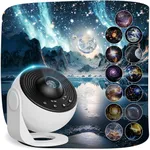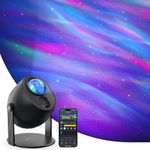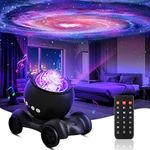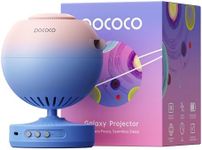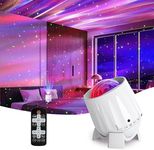Buying Guide for the Best Star Projectors
Choosing a star projector can be a fun way to bring the night sky into your home, whether for relaxation, education, or creating a magical atmosphere. To find the best fit for you, it's important to think about where and how you'll use it—like in a bedroom, living room, or for parties. Consider who will use it most, such as children or adults, and what kind of experience you want, from simple star patterns to more immersive galaxy effects. Understanding the key features will help you make a choice that matches your needs and expectations.Projection TypeProjection type refers to the kind of images the projector displays, such as simple stars, galaxies, planets, or even nebula clouds. This is important because it determines the overall effect and mood the projector creates. Some projectors only show basic star patterns, while others offer more complex and colorful scenes. If you want a realistic night sky, look for projectors with detailed star maps. For a more dreamy or decorative effect, those with swirling clouds or multiple colors might be better. Think about whether you want a scientific, educational experience or a relaxing, ambient light show to guide your choice.
Brightness and Light SourceBrightness is how intense the projected images appear, and the light source (like LED or laser) affects both brightness and clarity. This matters because a projector that's too dim may not be visible in larger or brighter rooms, while one that's too bright could be overwhelming in a small, dark space. LEDs are common and safe for home use, while lasers can offer sharper images but may require more caution. If you plan to use the projector as a night light or for children, a softer brightness is ideal. For parties or larger rooms, a brighter projector will be more effective.
Projection Coverage and FocusProjection coverage describes how much of the ceiling or walls the projector can illuminate, and focus refers to how sharp the images appear. This is important because a projector with a wide coverage can fill an entire room, while a narrow one might only cover a small area. Adjustable focus lets you make the stars or patterns clearer, especially if you change the distance between the projector and the surface. If you want to create a full-room effect, look for wide coverage and adjustable focus. For smaller spaces or targeted displays, a more focused, limited coverage may be enough.
Power Source and PortabilityPower source means how the projector is powered—by batteries, USB, or a wall plug. Portability is about how easy it is to move the projector from place to place. This matters if you want to use the projector in different rooms or take it on trips. Battery-powered or USB models are more portable and flexible, while plug-in models may offer more consistent power for longer use. If you plan to move the projector often or use it outdoors, portability and battery options are key. For a permanent setup, a plug-in model might be more convenient.
Timer and Auto-Off FeaturesA timer or auto-off feature lets you set the projector to turn off automatically after a certain time. This is important for safety and convenience, especially if you use the projector as a night light or want it to turn off after you fall asleep. Some projectors offer multiple timer settings, while others may not have this feature at all. If you want to use the projector overnight or for children, a timer is very helpful. For occasional or short-term use, this feature may be less important.
Sound and Extra FeaturesSome star projectors come with built-in speakers, nature sounds, or Bluetooth connectivity for playing music. These extras can enhance the atmosphere and make the experience more immersive. If you enjoy relaxing with music or want a multi-sensory experience, look for projectors with these features. If you prefer a simple, quiet projection, you may not need them. Think about how you plan to use the projector and whether these extras will add value for you.


